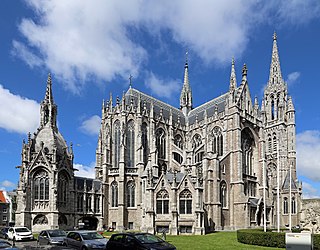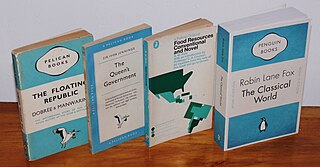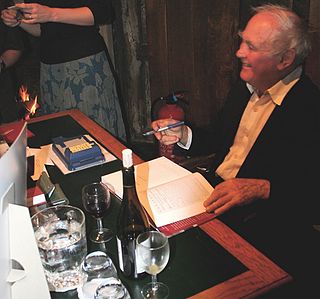
Corpus Christi College is one of the constituent colleges of the University of Oxford in the United Kingdom. Founded in 1517, it is the 12th oldest college in Oxford.

Sir Nikolaus Bernhard Leon Pevsner was a German-British art historian and architectural historian best known for his monumental 46-volume series of county-by-county guides, The Buildings of England (1951–74).

Gothic Revival is an architectural movement that began in the late 1740s in England. The movement gained momentum and expanded in the first half of the 19th century, as increasingly serious and learned admirers of the neo-Gothic styles sought to revive medieval Gothic architecture, intending to complement or even supersede the neoclassical styles prevalent at the time. Gothic Revival draws upon features of medieval examples, including decorative patterns, finials, lancet windows, and hood moulds. By the middle of the 19th century, Gothic had become the preeminent architectural style in the Western world, only to fall out of fashion in the 1880s and early 1890s.

Penguin Books is a British publishing house. It was co-founded in 1935 by Allen Lane with his brothers Richard and John, as a line of the publishers The Bodley Head, only becoming a separate company the following year. Penguin revolutionised publishing in the 1930s through its inexpensive paperbacks, sold through Woolworths and other stores for sixpence, bringing high-quality fiction and non-fiction to the mass market. Its success showed that large audiences existed for serious books. It also affected modern British popular culture significantly through its books concerning politics, the arts, and science.

Palladian architecture is a European architectural style derived from the work of the Venetian architect Andrea Palladio (1508–1580). What is today recognised as Palladian architecture evolved from his concepts of symmetry, perspective and the principles of formal classical architecture from ancient Greek and Roman traditions. In the 17th and 18th centuries, Palladio's interpretation of this classical architecture developed into the style known as Palladianism.

Yale University Press is the university press of Yale University. It was founded in 1908 by George Parmly Day, and became an official department of Yale University in 1961, but it remains financially and operationally autonomous.
Sir John Newenham Summerson was one of the leading British architectural historians of the 20th century.

An iwan is a rectangular hall or space, usually vaulted, walled on three sides, with one end entirely open. The formal gateway to the iwan is called pishtaq, a Persian term for a portal projecting from the facade of a building, usually decorated with calligraphy bands, glazed tilework, and geometric designs. Since the definition allows for some interpretation, the overall forms and characteristics can vary greatly in terms of scale, material, or decoration.

Pelican Books is a non-fiction imprint of Penguin Books founded by Allen Lane and V K Krishna Menon. It publishes inexpensive paperbacks of academic topics intended to reach a broader audience. The imprint originally operated from 1937 to 1984, and was relaunched in April 2014.

Vkhutemas was the Russian state art and technical school founded in 1920 in Moscow, replacing the Moscow Svomas.

Axel Boëthius was a scholar and archaeologist of Etruscan culture. Boëthius was primarily a student of Etruscan and Italic architecture. His father was the historian Simon Boëthius.

The Survey of London is a research project to produce a comprehensive architectural survey of central London and its suburbs, or the area formerly administered by the London County Council. It was founded in 1894 by Charles Robert Ashbee, an Arts-and-Crafts designer, architect and social reformer and was motivated by a desire to record and preserve London's ancient monuments. The first volume was published in 1900, but the completion of the series remains far in the future.
The Alice Davis Hitchcock Book Award, established in 1949, by the Society of Architectural Historians, annually recognizes "the most distinguished work of scholarship in the history of architecture published by a North American scholar." The oldest of the six different publication awards given annually by the Society, it is named after the mother of architectural historian Henry-Russell Hitchcock.
William H. Jordy was a leading American architectural historian. At the time of his death, Jordy was Henry Ledyard Goddard Professor Emeritus of Art History at Brown University, where he taught for many years.

John Frederick Harris OBE was an English curator, historian of architecture, gardens and architectural drawings, and the author of more than 25 books and catalogues, and 200 articles. He was a Fellow and Curator Emeritus of the Drawings Collection of the Royal Institute of British Architects, founding Trustee of Save Britain's Heritage and Save Europe's Heritage, and founding member and Honorary Life President of the International Confederation of Architectural Museums.

Alexander Tzonis is a Greek-born architect, author, and researcher. He has made contributions to architectural theory, history and design cognition, bringing together scientific and humanistic approaches in a synthesis. Since 1975, he has been collaborating in most projects with Liane Lefaivre. In 1985, he founded and directed Design Knowledge Systems (DKS), a multidisciplinary research institute for the study of architectural theory and the development of design thinking tools at TU Delft. Tzonis is known for his work on the classical canon, history of the emergence and development of modern architectural thinking, creative design by analogy, and introducing the idea of critical regionalism.
William Watson was a British art historian who was Professor of Chinese art and archaeology at the University of London. He was a leading member of the teams that organised the Genius of China exhibition at the Royal Academy in 1973 and the Great Japan Exhibition, held in 1981–82. He made a major contribution to Japanese art studies in the UK.
The Pevsner Architectural Guides are a series of guide books to the architecture of Great Britain and Ireland. Begun in the 1940s by the art historian Sir Nikolaus Pevsner, the 46 volumes of the original Buildings of England series were published between 1951 and 1974. The series was then extended to Scotland, Wales and Ireland in the late 1970s. Most of the English volumes have had subsequent revised and expanded editions, chiefly by other authors.

In architecture, batter is a receding slope of a wall, structure, or earthwork. A wall sloping in the opposite direction is said to overhang. When used in fortifications it may be called a talus.

John Arthur Newman is an English architectural historian. He is the author of several of the Pevsner Architectural Guides and is the advisory editor to the series.















